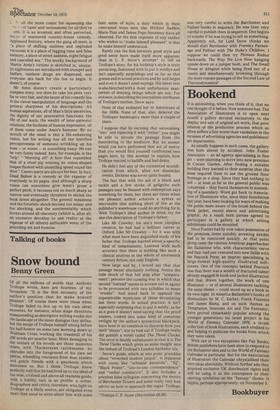Bookend
It is astonishing, when you think of it, that no one thought of it before. Now someone has. The Association of Illustrators is to open next month a gallery devoted exclusively to the display and sale of original art-work, that poor relation of the production process which so often suffers a fate worse than vandalism in the recesses of advertising agencies and publishers' art departments.
As usually happens in such cases, the gallery was born almost by accident. John Foster Associates — an ad agency specialising in fine .art — were planning to move into new premises in Covent Garden. After finding a suitable building they learned to their surprise that the lease required them to use the ground floor frontage as a shop. Since they had nothing to sell — at least as far as the general public was concerned — they found themselves in something of a quandary. Word got back to Association of Illustrators who, since their foundation last year, have been looking for ways of making the public more aware of the brush behind the book jacket, record sleeve and advertising graphic. As a result both parties agreed to participate in a gallery at which selling exhibitions could be mounted.
Since Fosters had by now taken possession of the premises, some suitably arresting exhibit had to be concocted quickly. At that point along came the veteran American paperbacker Ian Ballantine who, with characteristic verve and flair, had just ventured into new fields with his Peacock Press, an imprint specialising in large-format high-quality illustrated softcovers. One of the concepts behind Peacock was that there was a wealth of fractured talent already engaged in book and jacket illustration and that, drawn together, the work of one illustrator — or of several illustrators tackling the same theme — could stand up as a book in its own right. In America Ballantine's books of illustrations by M. C. Escher, Frank Frazetta and James Bama, and on such themes as Temptation, Innocent Art and The Fantastic, have proved remarkably popular among the younger generation; his latest project is his World of Fantasy Calendar 1976, a lavish collection of book illustrations, each credited to and helping to publicise the books from which they were taken.
With one or two exceptions like Pan Books, British publishers have been slow to respond to the Ballantine idea and to the World of Fantasy Calendar in particular. But for the Association of Illustrators the Calendar chrystallised their own ideas absolutely. Without further ado they acquired exclusive UK distribution rights and will be using it as the centrepiece to their opening exhibition on the "fantasy" theme. It begins, perhaps appropriately, on November 5.
I3ookbuyer


































 Previous page
Previous page